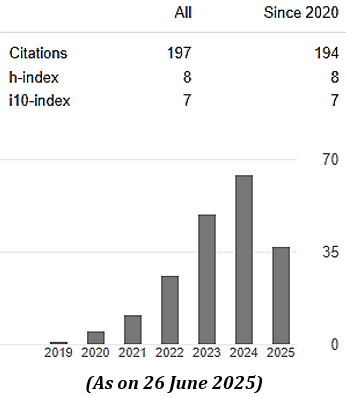Dynamic Responses of Padma Multipurpose Bridge Truss due to Moving Train Load
Abstract
Padma Multipurpose Bridge (PMB) is one of the most important projects in the history of Bangladesh due to its regional importance, economic benefit, and primary connectivity of one-third population of the country. The bridge is 6.15km long, connecting the ends of Mawa and Janjira in Bangladesh. The entire project is challenging to construct and complex in design as it contains both four-lane highways and train tracks supported by a double-deck composite warren truss. In this study, the dynamic response of the truss due to the moving train has been analyzed using the Moving Element Method (MEM). In this process, a separate finite element model has been developed using Finite Element (FE) program to convert the double deck truss into an equivalent beam. Analysis has been conducted for a series of different load cases, converging to the most realistic case where the actual train parameters are considered. Parametric studies have been carried out to determine the dynamic responses of the bridge with varying pier spacing and speed of the train. The most optimal solution has been discussed with the effect of the vibration of the train acting on the multi-purpose Padma bridge. The bridge's dynamic amplification factor (DAF) at a design speed of below 100km/hr is found 1.05. The parametric study shows that the critical train speed for the PMB is 1400km/hr resulting in the bridge resonance with a DAF of 18. It is also evident that with the increase of pier spacing the resonance of the bridge is expected to occur at a relatively lower speed.
Downloads
References
Ahmed, K. & Moniruzzaman, S. (2022) Seismic Evaluation of Padma Multipurpose Bridge Pier Using Response Spectrum Analysis. 5th Annual Paper Meet & 2nd Civil Engineering Congress, July 30-31, 2022 Dhaka, Bangladesh. 115-122.
Ahmed, K. S., Shahjalal, M., Siddique, T. A. & Keng, A. K. (2021). Bond strength of post-installed high strength deformed rebar in concrete. Case Studies in Construction Materials, e00581.
Bangladesh Bridge Authority (BBA), (2022). Padma Multipurpose Bridge Project, Ministry of Road Transport and Bridges.
Cao, T. N. T., Reddy, J., Ang, K. K., Luong, V. H., Tran, M. T. & Dai, J. (2018). Dynamic analysis of three-dimensional high-speed train-track model using moving element method. Advances in Structural Engineering, 862 - 876.
Dai, J., Ang, K. K., Jiang, D., Luong, V. H. & Tran, M. T. (2018a). Dynamic Response of High-Speed Train-Track Systems Due to unsupported sleepers. International Journal of Structural Stability and Dynamics, 18, 25.
Dai, J., Ang, K. K., Tran, M. T., Luong, V. H. & Jiang, D. (2018b). Moving Element Analysis of discretely supported high-speed rail system. Journal of Rail and Rapid Transit, 783 - 797.
Eftekhari, S. A. (2015). A note on mathematical treatment of the Dirac - delta function in differential quadrature bending and forced vibration analysis on beams and rectangular plates subjected to concentrated loads. Applied Mathematical Modelling, 6223 - 6242, 2015.
Erochko, J. (2020). Structural Analysis. Structural Analysis. Ottawa.
Farzana, K. & Ahmed, K. (2020). Performance based seismic analysis of stainless steel reinforced concrete bridge pier using damping ductility relationship. IABSE-JSCE Joint Conference on Advances in Bridge Engineering-IV August 26-27, 2020 Dhaka, Bangladesh. 115-122.
Farzana, K. & Ahmed, K. (2022). Seismic Evaluation of Stainless Steel-Reinforced Concrete Bridge Pier Using Performance-Based Damage States. Advances in Civil Engineering. Springer.
Institute, E. A. E. S. (2018). Fact Sheet: High Speed Rail Development Worldwide. EESI Web site.
Kim Y. J. (2017). National Academies of Sciences Engineering and Medicine (U.S.). American Association of State Highway and Transportation Officials National Cooperative Highway Research Program & United States. Proposed AASHTO LRFD bridge design specifications for light rail transit loads. Transportation Research Board.
Koh C. G., Ong J. S. Y., Chua D. K. H. & Feng J. (2003). Moving element method for train-track dyanmics. International Journal for Numerical Methods in Engineering, 1549 - 1567.
Lee C. H., Kawatani M., Kim C. W., Nishimura N. & Kobayashi Y. (2006). Dynamic Response of a Monorail Steel Bridge under a moving train. Journal of Sound and Vibration, 294, 562 - 579.
Lin Y. H. & Trethewey M. W. (1989). Finite Element Analysis of Elastic Beams subjected to Moving Dyanmic Loads. Journal of Sound and Vibration, 323 - 342.
Loubinoux J. P. (2012). High Speed Rail, Fast track to sustainable mobility. International Union of Railways, June 2012.
Mahmud R. & Ahmed K. S. (2020). Interface dependency of reinforced concrete jacketing for column strengthening. Proceedings of the Institution of Civil Engineers–Structures Buildings, 173, 31-41.
Sun S., Deng H., & Li W. (2014). Variable stiffness and damping suspension system for train (SPIE Smart Structures and Materials and Nondestructive Evaluation and Health Monitoring). SPIE, 2014.
MIJST follows the open access policy.

This work is licensed under a Creative Commons Attribution-NonCommercial 4.0 International License. This allows anyone to copy, share, distribute, and modify the work for non-commercial purposes, where the original work and source should be properly credited.
















